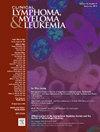Treatment Patterns and Outcomes of Multiple Myeloma Patients Undergoing Second-Line Therapy: A Canadian Myeloma Research Group (CMRG) Analysis
IF 2.7
4区 医学
Q2 HEMATOLOGY
引用次数: 0
Abstract
Introduction
First-line treatment in Canadian transplant-eligible MM patients is CyBorD/RVD followed by ASCT and maintenance lenalidomide. In transplant ineligible patients, bortezomib- or lenalidomide-based treatment is used. Relapse options include salvage ASCT or diverse doublet/triplets. Limited data support any one approach. The aim of this study was to assess treatment patterns/outcomes of real-world patients at first relapse.
Methods
All patients initiating second-line therapy from January 1/10 to June 30/22 were included. We evaluated ORR, PFS and OS, calculated from the start of second-line.
Results
A total of 3569 patients were included, 1638 (45.9%) with prior ASCT and 1931 (54.1%) without. The most used regimens were Rd, DRd, CyBorD, ASCT, RVd and DVd. The highest ORRs were seen with DRd (90%), ASCT (89%), Kd/KCd (79%), RVd (78.1%) and KRd (74%). For drug regimens, median PFS (27.6 months) and OS (75.5 months) were longest for DRd.
Conclusions
We evaluated impact of second-line treatment in MM patients. Triplets with an IMiD backbone and carfilzomib combinations had high ORR and durable PFS, with select patients undergoing second ASCT achieving durable responses. Given the expanding use of IMiD, PI and CD38 mAbs frontline, our results highlight the need for modern modalities at first relapse and provide a benchmark for implementation.
多发性骨髓瘤患者接受二线治疗的治疗模式和结果:加拿大骨髓瘤研究小组(CMRG)分析。
加拿大符合移植条件的MM患者的一线治疗是CyBorD/RVD,然后是ASCT和维持性来那度胺。对于不适合移植的患者,使用硼替佐米或来那度胺为基础的治疗。复发选择包括补救性ASCT或多种双/三胞胎。有限的数据支持任何一种方法。本研究的目的是评估现实世界中首次复发患者的治疗模式/结果。方法:纳入1月1日至6月30日至22日接受二线治疗的所有患者。我们评估ORR, PFS和OS,从二线开始计算。结果:共纳入3569例患者,其中1638例(45.9%)有ASCT病史,1931例(54.1%)无ASCT病史。最常用的方案是Rd、DRd、CyBorD、ASCT、RVd和DVd。DRd(90%)、ASCT(89%)、Kd/KCd(79%)、RVd(78.1%)和KRd(74%)的orr最高。对于药物方案,DRd的中位PFS(27.6个月)和OS(75.5个月)最长。结论:我们评估了二线治疗对MM患者的影响。具有IMiD骨干和卡非佐米联合的三胞胎具有高ORR和持久的PFS,选择第二次ASCT的患者获得持久的反应。鉴于IMiD、PI和CD38单克隆抗体一线的使用不断扩大,我们的研究结果强调了在首次复发时采用现代治疗方式的必要性,并为实施提供了基准。
本文章由计算机程序翻译,如有差异,请以英文原文为准。
求助全文
约1分钟内获得全文
求助全文
来源期刊

Clinical Lymphoma, Myeloma & Leukemia
ONCOLOGY-HEMATOLOGY
CiteScore
2.70
自引率
3.70%
发文量
1606
审稿时长
26 days
期刊介绍:
Clinical Lymphoma, Myeloma & Leukemia is a peer-reviewed monthly journal that publishes original articles describing various aspects of clinical and translational research of lymphoma, myeloma and leukemia. Clinical Lymphoma, Myeloma & Leukemia is devoted to articles on detection, diagnosis, prevention, and treatment of lymphoma, myeloma, leukemia and related disorders including macroglobulinemia, amyloidosis, and plasma-cell dyscrasias. The main emphasis is on recent scientific developments in all areas related to lymphoma, myeloma and leukemia. Specific areas of interest include clinical research and mechanistic approaches; drug sensitivity and resistance; gene and antisense therapy; pathology, markers, and prognostic indicators; chemoprevention strategies; multimodality therapy; and integration of various approaches.
 求助内容:
求助内容: 应助结果提醒方式:
应助结果提醒方式:


